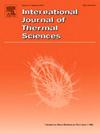聚合物熔体微尺度流动中粘度与黏性耗散耦合效应的理论与实验研究
IF 4.9
2区 工程技术
Q1 ENGINEERING, MECHANICAL
International Journal of Thermal Sciences
Pub Date : 2025-05-24
DOI:10.1016/j.ijthermalsci.2025.110022
引用次数: 0
摘要
聚合物熔体微成型过程中黏度与黏性耗散的耦合效应受微尺度效应的影响,对熔体的流动特性有显著影响。由于缺乏对这些耦合效应的理论探索,阻碍了微成型的发展。利用一种新的微尺度黏度模型,建立了黏度与黏度耗散通过共享变量温度耦合的数学模型。本研究对不同特征尺寸微通道内流变参数的变化进行了计算和分析,并通过实验验证了熔体沿流动方向的温度变化。结果表明:考虑耦合效应时,熔体沿流动方向和径向的温升与实验测量值更加吻合;随着特征维数的减小,沿流动方向和径向的平均温度偏差均增大。当特征尺寸为0.25 mm时,沿流动方向和径向的平均温度偏差分别为45.19%和41.08%。耦合效应对黏度和黏性耗散的影响也随特征维数的减小而增大。当特征尺寸为0.25 mm时,考虑和忽略耦合效应的最大偏差分别为57.03%和49.61%。这些结果证实了在聚合物熔体微成型过程中考虑耦合效应的必要性,验证了耦合数学模型的准确性。本文章由计算机程序翻译,如有差异,请以英文原文为准。
Theoretical and experimental study on the coupling effects between viscosity and viscous dissipation in microscale flow of polymer melts
The coupling effects between viscosity and viscous dissipation during the polymer melt micro-molding process, influenced by microscale effects, notably impacted the melt's flow characteristics. The scarcity of theoretical exploration into these coupling effects have hindered the evolution of micro-molding. A mathematical model that coupled viscosity and viscous dissipation through temperature, a shared variable, was built using a novel microscale viscosity model. The study performed calculations and analyses on the variation of rheological parameters within microchannels of varying characteristic dimensions and validated the temperature changes of the melt along the flow direction through experimentation. Results showed that when the coupling effects were considered, the temperature rise of the melt along both the flow direction and the radial direction aligned more closely with experimentally measured values. The average temperature deviations along the flow direction and the radial direction both increase as the characteristic dimension decreased. When the characteristic dimension was 0.25 mm, the average temperature deviations along the flow direction and the radial direction were 45.19 % and 41.08 %, respectively. The influence of the coupling effect on viscosity and viscous dissipation also increased with decreasing characteristic dimension. When the characteristic dimension was 0.25 mm, the maximum deviations between considering and neglecting the coupling effects were 57.03 % and 49.61 %, respectively. These findings confirmed the necessity of considering the coupling effect in polymer melt micro-molding and validated the accuracy of the coupled mathematical model.
求助全文
通过发布文献求助,成功后即可免费获取论文全文。
去求助
来源期刊

International Journal of Thermal Sciences
工程技术-工程:机械
CiteScore
8.10
自引率
11.10%
发文量
531
审稿时长
55 days
期刊介绍:
The International Journal of Thermal Sciences is a journal devoted to the publication of fundamental studies on the physics of transfer processes in general, with an emphasis on thermal aspects and also applied research on various processes, energy systems and the environment. Articles are published in English and French, and are subject to peer review.
The fundamental subjects considered within the scope of the journal are:
* Heat and relevant mass transfer at all scales (nano, micro and macro) and in all types of material (heterogeneous, composites, biological,...) and fluid flow
* Forced, natural or mixed convection in reactive or non-reactive media
* Single or multi–phase fluid flow with or without phase change
* Near–and far–field radiative heat transfer
* Combined modes of heat transfer in complex systems (for example, plasmas, biological, geological,...)
* Multiscale modelling
The applied research topics include:
* Heat exchangers, heat pipes, cooling processes
* Transport phenomena taking place in industrial processes (chemical, food and agricultural, metallurgical, space and aeronautical, automobile industries)
* Nano–and micro–technology for energy, space, biosystems and devices
* Heat transport analysis in advanced systems
* Impact of energy–related processes on environment, and emerging energy systems
The study of thermophysical properties of materials and fluids, thermal measurement techniques, inverse methods, and the developments of experimental methods are within the scope of the International Journal of Thermal Sciences which also covers the modelling, and numerical methods applied to thermal transfer.
 求助内容:
求助内容: 应助结果提醒方式:
应助结果提醒方式:


